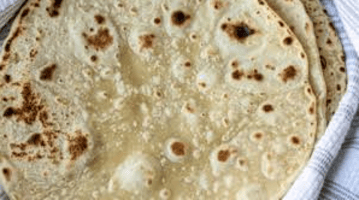Have you ever sunk your teeth into a perfect shawarma wrap and wondered, ‘How do they make this incredible bread?’ That soft, slightly chewy shawarma bread—also known as flour tortilla—is the unsung hero that cradles all those delicious fillings. Making shawarma bread at home might seem intimidating, but I’m here to tell you it’s absolutely achievable with the right technique.
This comprehensive guide to making shawarma bread (flour tortilla) will explore everything from traditional ingredients to foolproof methods that ensure perfect results every time.

What is Shawarma Bread?
Shawarma bread, commonly referred to as flour tortilla in many parts of the world, is a thin, unleavened flatbread that serves as the perfect vessel for shawarma fillings.
While traditional Middle Eastern shawarma might use specialized breads like lavash or markook, the flour tortilla has become an accessible and popular alternative that delivers that perfect combination of flexibility and texture needed to wrap shawarma fillings.
Making your own shawarma bread not only gives you control over ingredients but also provides that unmistakable freshness that store-bought versions simply can’t match.
Essential Ingredients for Perfect Shawarma Bread (Flour Tortilla)
The foundation of excellent shawarma bread begins with quality ingredients. Here’s what you’ll need:
Basic Ingredients:
- All-purpose flour (3 cups)
- Warm water (1 cup)
- Salt (1 teaspoon)
- ¼ cup of butter which has been melted or vegetable oil
- Baking powder (1 teaspoon) – optional, but helps create a softer texture
For Enhanced Flavor (Optional):
- Garlic powder (½ teaspoon)
- Dried herbs like oregano or thyme (½ teaspoon)
- Ground cumin (¼ teaspoon)
The quality of your flour greatly impacts the final texture of your shawarma bread. A medium-protein all-purpose flour works best, providing enough structure while maintaining softness.
Equipment Needed for Making Shawarma Bread
Before diving into preparation, gather these essential tools:
Must-Have Equipment:
- Large mixing bowl
- Measuring cups and spoons
- Rolling pin
- Flat griddle, cast iron skillet, or non-stick pan
- Spatula
- Clean kitchen towel or tortilla warmer
- Airtight container for storage
Helpful Additions:
- Stand mixer with dough hook (for easier mixing)
- Tortilla press (speeds up the flattening process)
- Food scale (for consistent dough ball sizes)
- Bench scraper (for dividing dough)
While specialized equipment like a tortilla press can make the process more efficient, don’t worry if you don’t have one—a simple rolling pin works perfectly fine for creating thin, even shawarma bread.

Step-by-Step Preparation of Homemade Shawarma Bread
Making perfect shawarma bread requires attention to detail at each stage. Follow this comprehensive method for outstanding results:
Mixing the Dough:
- Whisk the flour, salt, and baking powder (if using) in a large bowl.
- Then, make a well in the middle and add the oil or melted butter.
- Using your hands or a wooden spoon to mix, slowly pour in warm water
- Continue mixing until the ingredients come together to form a shaggy dough.
- Transfer to a floured surface and knead for 5 to 7 minutes, or until the dough is smooth and elastic.
- The dough should feel soft but not sticky—adjust with small amounts of flour or water if needed.
Resting the Dough:
- Place the kneaded dough in an oiled bowl after forming it into a ball.
• Cover cloth that is a bit wet or with plastic wrap - At room temperature, let the dough rest for at least half an hour (between 30mins to 2 hours).
- This crucial resting period allows the gluten to relax, making the dough easier to roll thin.
Portioning and Shaping:
- Put the dough on a surface dusted with flour when it has rested.
- Divide into 8-10 equal portions (about 50-60g each) for medium-sized shawarma bread.
- Create a smooth ball out of each part.
- To keep the dough balls from drying out while you work, cover them with a towel.
Rolling Out the Tortillas:
- Using your palm, flatten a single ball of dough.
- Using a rolling pin, roll from the center outward in all directions.
- what you are looking for is a narrow circle with a diameter of 8 to 10 inches
- Lift and rotate the dough frequently to ensure even rolling and prevent sticking.
- For extra-thin shawarma bread, roll until you can almost see through the dough.
Cooking the Shawarma Bread:
- Heat a dry skillet or griddle over medium-high heat until hot.
- Carefully transfer the rolled dough to the hot surface.
- Cook for 30-45 seconds until bubbles form on the surface and light brown spots appear on the bottom.
- Cook for 30 seconds on the opposite side after flipping.
- The perfect shawarma bread should have sporadic brown spots while remaining soft and pliable.
Keeping Warm:
- Stack cooked shawarma bread in a clean kitchen towel or tortilla warmer.
- The steam created helps keep them soft and flexible.
- Allow them to cool slightly before using for shawarma wraps.
Enhancing Your Shawarma Bread with Variations
The basic flour tortilla recipe provides an excellent foundation, but consider these variations to customize your shawarma bread:
Whole Wheat Option:
- Replace up to half the all-purpose flour with whole wheat flour for a nuttier flavor and added nutrients.
- When using whole wheat flour, you might need to add a little extra water.
Herbed Shawarma Bread:
- Add 1-2 teaspoons of dried herbs like oregano, thyme, or za’atar to the dry ingredients.
- These subtle flavor additions complement traditional shawarma fillings.
Garlic-Infused Oil:
- Replace regular oil with garlic-infused oil for subtle flavor throughout the bread.
- Simply warm your oil with minced garlic, strain, and cool before adding to the dough.
Yogurt Addition:
- Substitute half the water with plain yogurt for a slightly tangy flavor and tender texture.
- This creates a bread reminiscent of traditional lavash.
Storage Tips for Freshness
Proper storage ensures your homemade shawarma bread remains fresh and ready for use:
Short-Term Storage:
- Allow shawarma bread to cool completely.
- Stack with pieces of parchment or wax paper between each tortilla.
- Keep in a ziplock bag or sealed container.
- Store at room temperature for 1-2 days.
Refrigeration:
- Following the same stacking method, refrigerate for up to 1 week.
- Bring to room temperature before using, or briefly reheat.
Freezer Storage:
- For longer storage, freeze with parchment paper between each bread.
- Place in a freezer bag with air removed.
- Freeze for up to 3 months.
- Thaw in the fridge for the entire night or for a few hours at room temperature.
Reheating Methods:
- Microwave: Leave in there for 10 to 15 seconds while wrapped in a moist paper towel.
- Skillet: Warm for 15-20 seconds per side over medium heat.
- Oven: Cover with foil and cook for 5 to 7 minutes at 300°F (150°C).

Troubleshooting Common Issues
Even experienced bakers encounter challenges with shawarma bread. Here are solutions to common problems:
Tough or Rigid Tortillas:
- Cause: Overworked dough or insufficient fat.
- Solution: Knead more gently and ensure you’ve added enough oil or butter.
Tortillas That Won’t Stretch:
- Cause: Insufficient resting time or inadequate kneading.
- Solution: Allow longer rest periods and ensure proper gluten development through kneading.
Dough Sticking to Surface:
- Cause: Too much hydration or insufficient flour on work surface.
- Solution: Use adequate flour for dusting and adjust water in the recipe if consistently too sticky.
Uneven Cooking:
- Cause: Inconsistent thickness or heat distribution.
- Solution: Roll more evenly and ensure your pan is properly preheated.
Tortillas Drying Out Quickly:
- Cause: Overcooked or improperly stored.
- Solution: Cook for less time and immediately transfer to a covered towel to trap steam.
Pairing Your Shawarma Bread with Delicious Fillings
Your homemade shawarma bread deserves equally delicious fillings. Consider these classic combinations:
Traditional Chicken Shawarma:
- Marinate chicken in yogurt, lemon juice, and shawarma spices.
- Serve with garlic sauce, pickled vegetables, and fresh herbs.
Beef or Lamb Shawarma:
- Season with cumin, allspice, and cinnamon.
- Pair with tahini sauce and chopped tomatoes and cucumbers.
Vegetarian Shawarma:
- Roast cauliflower or chickpeas with shawarma spices.
- Add hummus, tabbouleh, and pickled turnips.
Your homemade shawarma bread (flour tortilla) provides the perfect canvas for these fillings, with its strength and flexibility holding everything together while adding its subtle flavor.
Important Temperature Control Tips
Temperature plays a crucial role in successful shawarma bread:
Water Temperature:
- Use warm water (105-110°F/40-43°C)—similar to body temperature.
- Too hot can kill yeast if you’re using a yeasted variation.
- Too cold will slow gluten development.
Cooking Temperature:
- Medium-high heat (375-400°F/190-205°C) is ideal.
- Too hot causes burning before cooking through.
- Too cool results in dry, hard tortillas.
Dough Temperature:
- Room temperature dough (68-72°F/20-22°C) rolls out most easily.
- Cold dough from the refrigerator should rest 30 minutes before rolling.
FAQs
Can I make shawarma bread ahead of time?
Absolutely! You can prepare shawarma bread up to three days in advance. Just make sure to store them properly with parchment paper between each tortilla in an airtight container.
For longer storage, freeze them with parchment paper separators in a freezer bag for up to three months. When ready to use, thaw completely and briefly warm them on a dry skillet to restore their soft, pliable texture.
Is shawarma bread the same as flour tortillas?
While traditional Middle Eastern shawarma might use specialized flatbreads like lavash or markook, flour tortillas have become a popular and accessible alternative for making shawarma wraps.
The flour tortilla provides the perfect combination of strength and flexibility needed for wrapping shawarma fillings.
How can I make my shawarma bread softer and more pliable?
First, don’t skimp on the fat—oil or butter contributes greatly to softness. Second, don’t overwork the dough or overcook the tortillas. Third, the steam-capture method is crucial: immediately after cooking, stack the tortillas and wrap them in a clean kitchen towel or place them in a tortilla warmer.
This trapped steam helps maintain moisture and flexibility. Finally, adding a bit of baking powder to the dough can create a slightly fluffier texture.
What’s the difference between shawarma bread and pita bread?
Shawarma bread (when made as flour tortillas) and pita bread differ primarily in thickness, ingredients, and cooking method. Pita bread is thicker, typically leavened with yeast, and develops a pocket during baking in a hot oven.
Shawarma bread, when made as flour tortillas, is thinner, usually unleavened (though sometimes contains baking powder), and is cooked on a griddle or skillet. While pita is opened to create a pocket for fillings, shawarma bread is wrapped around ingredients.
Can I make gluten-free shawarma bread?
Yes, you can make gluten-free shawarma bread by substituting all-purpose flour with a gluten-free flour blend that contains xanthan gum (or add 1 teaspoon of xanthan gum per cup of gluten-free flour).
The texture will be slightly different—often less elastic and more prone to cracking—but still workable for shawarma wraps. Adding a tablespoon of psyllium husk powder to the dough can improve flexibility.
Conclusion…
Mastering the art of making shawarma bread (flour tortilla) at home is truly a culinary skill worth developing. With just a handful of pantry staples and some practice, you can create freshly made wraps that elevate your shawarma experience to new heights.
The satisfaction of biting into a shawarma wrapped in bread you’ve crafted with your own hands simply can’t be matched by store-bought alternatives. So, gather your ingredients, clear some counter space, and embark on this rewarding culinary adventure.
Your homemade shawarma bread will not only transform your meals but might just make you the most popular chef among friends and family.
